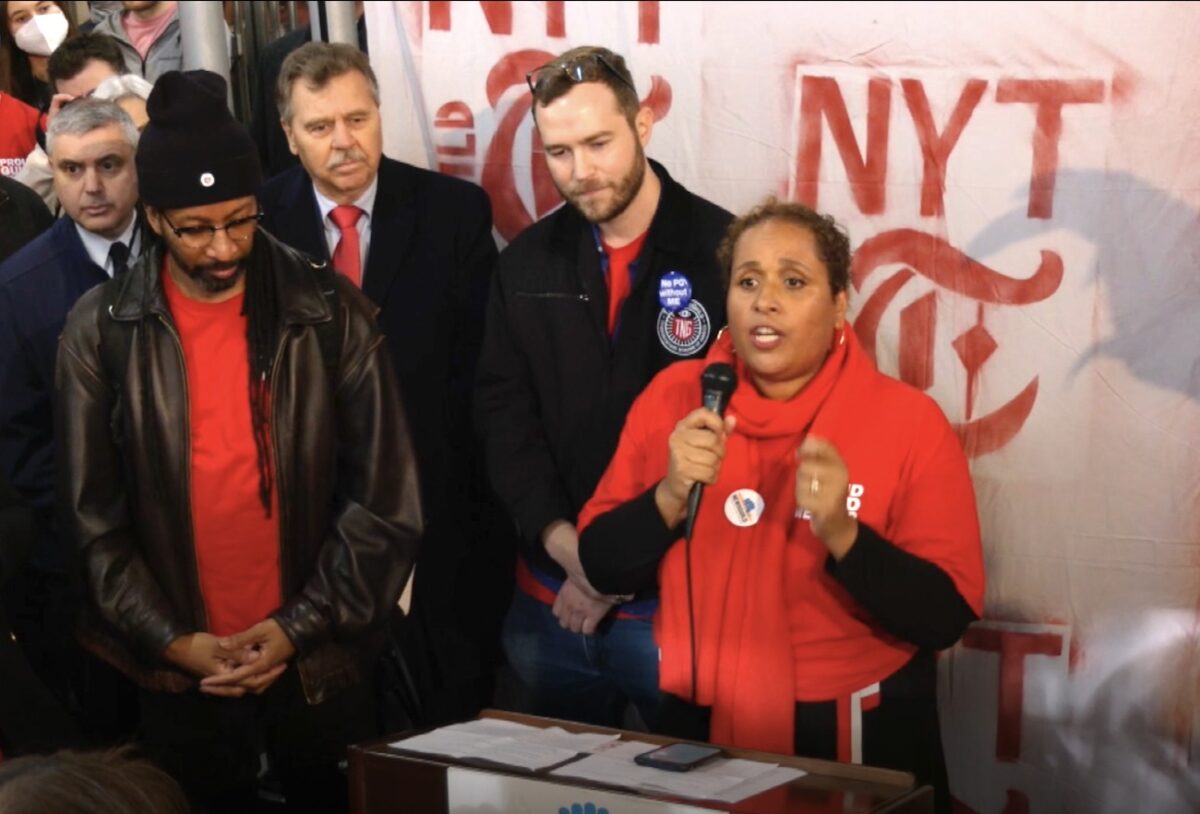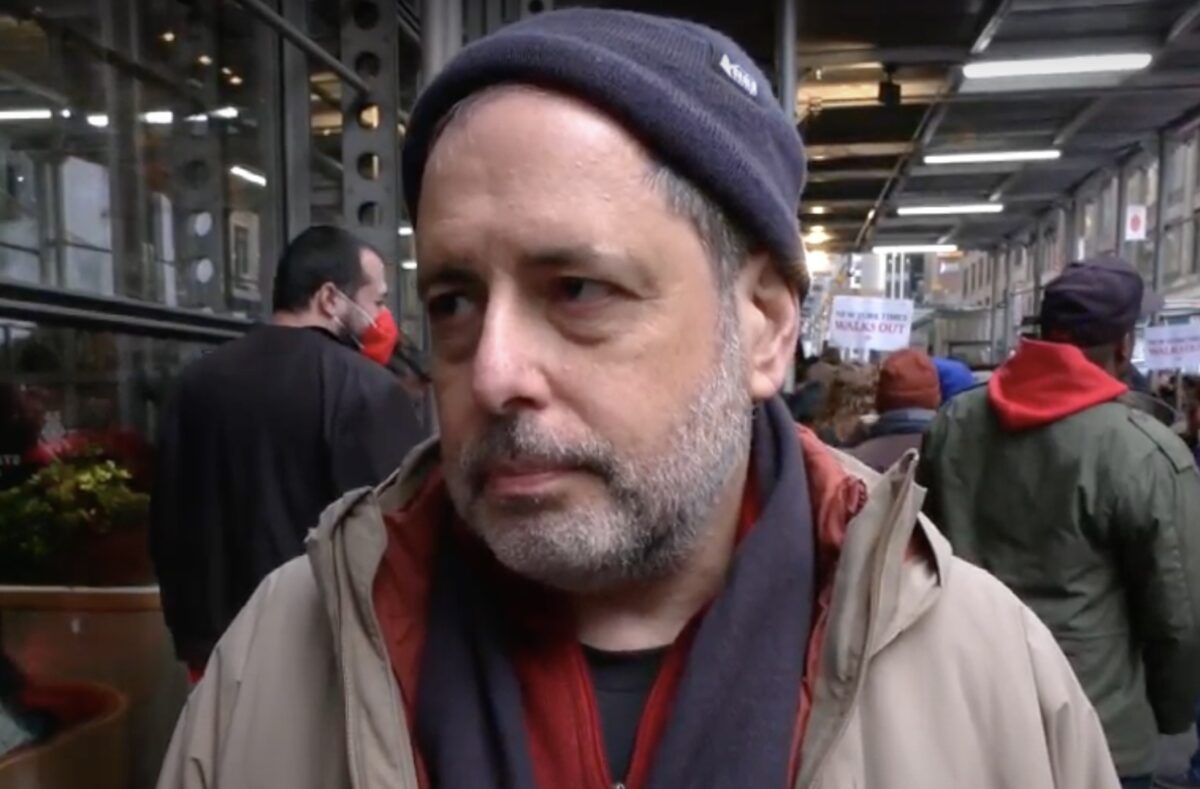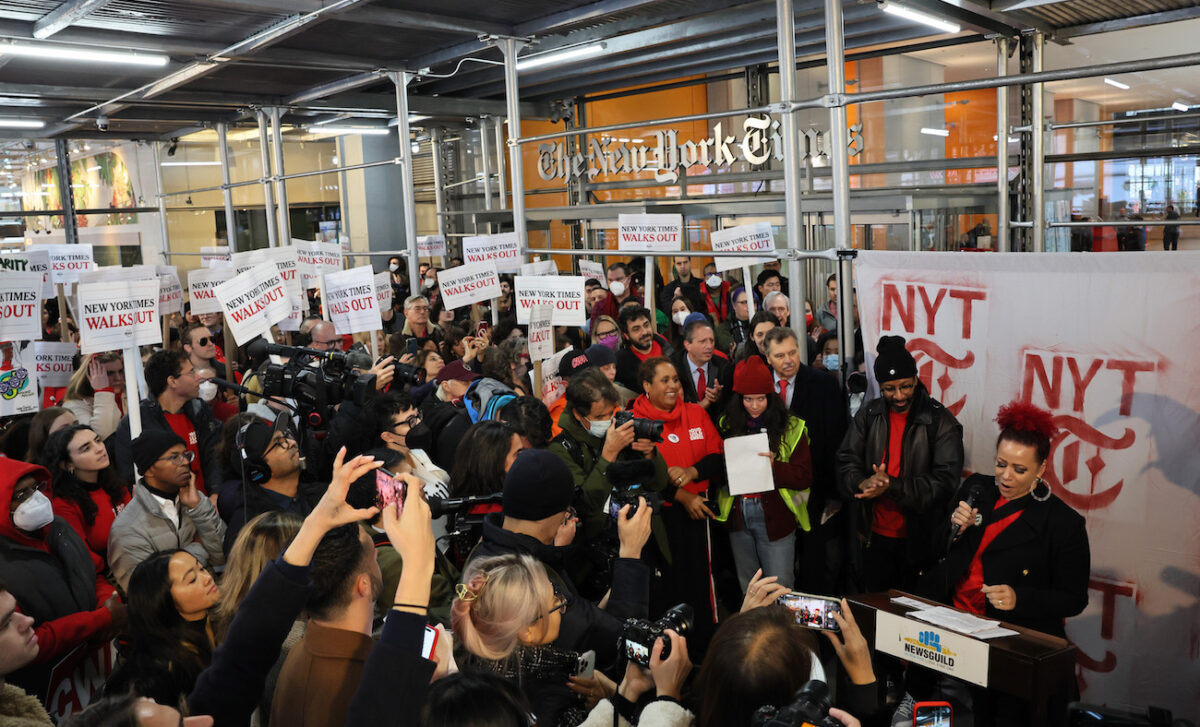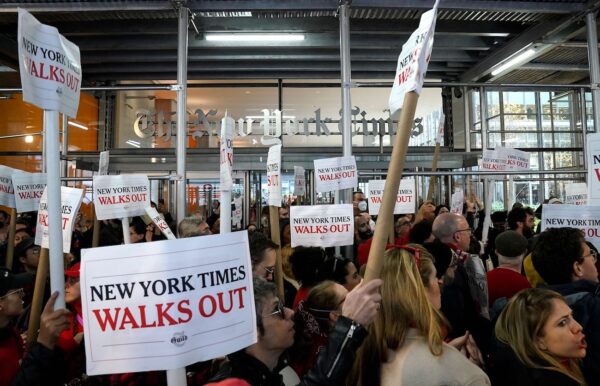At the headquarters of The New York Times in midtown Manhattan on Thursday, employees held a picket-line demonstration with many donning red shirts and holding signs reading “New York Times Walks Out.”
“There is no New York Times without your labor,” Susan DeCarava, president of the NewsGuild of New York, told the crowd at the rally in front of the company’s building, which was held around 1 p.m.
The NewsGuild of New York is a collective union of media workers that includes those from the New York Times Guild, a union that represents New York Times employees.
“We won’t allow them to take advantage of your loyalty,” she said. “Without the work of our members of the NewsGuild of New York, without all the workers at The [New York] Times, this place is an empty building, it’s a blank page. And it’s a company that’s not living up to its values unless we demand that they do so.”

The on-site demonstration was part of a 24-hour strike that over 1,100 New York Times journalists and other employees held on the day, marking the paper’s largest labor dispute in more than 40 years.
In a breakthrough that both sides regarded as significant, the company’s representatives backed off its proposal to replace the existing adjustable pension plan with an enhanced 401(k) retirement plan. It offered instead to let the union choose between the two. It also agreed to expand fertility treatment benefits.
The company has offered to raise wages by 5.5 percent upon ratification of the contract, followed by 3 percent increases in 2023 and 2024. That would represent an increase from the 2.2 percent annual increases in the expired contract.
Meanwhile, the union is seeking 10 percent pay raises at ratification, and 5.5 percent raises in 2023 and 2024.
‘Our Attempt to Be Made Whole’
“We don’t want to go on strike, nobody wants to go on strike,” said Ken Belson, a reporter for The New York Times sports department, and part of the bargaining committee of the New York Times Guild. “We wanted a fair deal. The company refuses to give us a fair wage increase. They tried to destroy our pension and take away our health care funding.”

“We have not had a contract for almost two years and we did not get a raise for a year before that,” Belson told NTD, a sister media outlet to The Epoch Times. “This has been during high inflation—inflation is 8, 9, 10 percent in one of the most expensive cities in the world. We have not had a raise. We are all falling behind. We’re asking for a raise that makes us whole for a very traumatic period. A lot of us have had extra costs, work at home, health care costs. … This is our attempt to be made whole.”
Nikole Hannah-Jones, a Pulitzer Prize-winning journalist for the New York Times Magazine, said outside the Times’ building on Thursday, “We are here because we know The New York Times is nothing without its guild and every last one of us deserves to earn livable wage and to receive the benefits that we deserve.”
“You shouldn’t have to struggle financially to work at a place like The New York Times no matter what your position is,” she also said.

NY Times Not Struggling Financially: Protesters
Belson noted that the newspaper itself is not struggling financially.
“Part of our message here is that the company is not in trouble,” he told NTD. “There are many newspapers around the country that are [in trouble]. The New York Times is very profitable. They spent $150 million for shareholders, they bought The Athletic website for $550 million. They have the money. They’re just not spending it on us.”
The company spent $150 million in stock buybacks to investors—”$150 million, by the way, would have paid for the entirety of our contract,” DeCarava pointed out to protesters at the rally.
“Now they need to know that they need to make better choices or else they won’t be able to … increase executive compensation by over 30 percent,” she added, referring to the recent significant pay raises made to New York Times CEO Meredith Kopit Levien and Publisher A.G. Sulzberger.
DeCarava cited the COVID-19 pandemic and the “astronomical rise in cost of living” that prompted the New York Times Guild to seek for a new contract that would facilitate an increase in wages, an increase in the minimum pay for new employees, improved benefits, policies to allow remote work, and the preservation of pensions.

Newsroom Teams ‘Depleted’: Journalist
Journalists haven’t been given a working contract since March 2021, and the New York Times Guild alleged that the paper’s management has been stalling on negotiations for a new one. Last week, the union set a deadline of Thursday for obtaining a new contract. But negotiations fell apart late Wednesday. The union alleged that “management walked away from the table a little before 7 PM ET and refused to return.”
The company’s representatives said it was still amid negotiations when they were alerted of the 24-hour strike. “It is disappointing that they are taking such an extreme action when we are not at an impasse,” representatives said in a statement.
Joe Kahn, the executive editor of The New York Times, said in a note to the newsroom: “Strikes typically happen when talks deadlock. That is not where we are today. While the company and the NewsGuild remain apart on a number of issues, we continue to trade proposals and make progress toward an agreement.”
Kahn said Thursday’s news report would be “robust” but that producing it “will be harder than usual.” Rhoades Ha said the company had “solid plans in place” to continue producing content, including relying on international reporters and other journalists who are not union members.
Stacy Cowley, a finance reporter and chief union negotiator, said the strike nearly depleted many newsroom teams, including her own.
She said the union representatives had said that when several reporters informed editors they would join the strike, management ended bargaining for Wednesday night. She said the next scheduled negotiation session is Dec. 13.
At the rally, Cowley said there was momentum during negotiations this week and hoped for a breakthrough. “But if talks stall again we will be asking you for your trust and support for further actions,” Cowley told the crowd, which shouted back, “Whatever it takes!”
The Associated Press contributed to this report.









